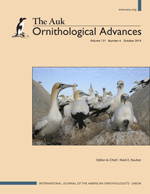Small-bodied birds engaging in incubation by a single sex experience a tradeoff between incubating to create a buffered thermal environment for their eggs and foraging to meet their own energetic requirements. This tradeoff is intensified in alpine environments, which are characterized by cold and variable conditions. We monitored the incubation rhythms of alpine Horned Larks (Eremophila alpestris) in British Columbia, Canada, across different annual thermal regimes (2005: moderate; 2006: warm; 2010: cold overnight; 2011: cold during the day). In this species, females alone incubated and left their nests to forage at dawn, following 7 hr of nighttime incubation in near-freezing conditions. However, with early morning ambient temperatures still <5°C, this placed embryos at high risk of chilling during incubation recesses. Focusing on behavioral decisions made by females at dawn (06:00–08:00 hours), we examined relationships between incubation rhythms and ambient temperature among years for evidence of variable responses to temperature. In all years, females spent more time off the nest at dawn in warmer temperatures, but in 2010, which was colder overnight, the slope of the line relating attentiveness to ambient temperature was steeper, indicating that females left their nests at colder temperatures compared with other years. In 2010 females also took shorter recesses at cold temperatures. Hatching success remained high in 2010 relative to warm or moderate years; however, overwinter survival of females declined to 48% from 2010 to 2011 compared with 72% in earlier years. When faced with exceptional thermal constraints, alpine Horned Larks made behavioral adjustments to their incubation rhythms and were able to maintain fecundity. However, potential survival costs to females implies a shift in balance of the parent–offspring tradeoff, revealing limits to coping mechanisms of alpine-breeding Horned Larks.
How to translate text using browser tools
23 July 2014
An alpine-breeding songbird can adjust dawn incubation rhythms to annual thermal regimes
Elizabeth C. MacDonald,
Alaine F. Camfield,
Jill E. Jankowski,
Kathy Martin
ACCESS THE FULL ARTICLE

The Auk
Vol. 131 • No. 4
October 2014
Vol. 131 • No. 4
October 2014
ambient temperature
annual variation
attentiveness
Eremophila alpestris
high elevation
Horned Lark
parent–offspring tradeoff




